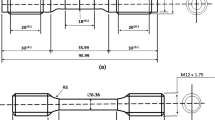The creep-fatigue interaction in directionally solidified nickel-base superalloy was analyzed with the modified Chaboche-based unified viscoplasticity constitutive model. The model features the anisotropic material behavior, hardening/softening, and stress relaxation. Simple low-cyclic fatigue and specified hold time experiments were conducted on a directionally solidified superalloy (DZ125) at temperatures over 760°C. The material parameters were optimized considering its tensile, cyclic and creep behavior with the Levenberg–Marquardt optimization procedure. The model was constructed in FORTRAN and integrated in FEA software UMAT/ABAQUS. The results show that experimental and simulated hysteresis loop size/shape, peak stresses, stress relaxation, and related areas are closely matched. The modified constitutive model was found to be instrumental for revealing the fatigue and creep-fatigue interaction behavior of such materials and can be used for practical applications.




Similar content being viewed by others
References
R. A. Kupkovits and R. W. Neu, “Thermomechanical fatigue of a directionally- solidified Ni-base superalloy: Smooth and cylindrically-notched specimens,” Int. J. Fatigue, 32, No. 8, 1330–1342 (2010).
M. M. Shenoy, D. L. McDowell, and R. W. Neu, “Transversely isotropic viscoplasticity model for a directionally solidified Ni-base superalloy,” Int. J. Plasticity, 22, No. 12, 2301–2326 (2006).
D. Shi, C. Dong, X. Yang, et al., “Creep and fatigue lifetime analysis of directionally solidified superalloy and its brazed joints based on continuum damage mechanics at elevated temperature,” Mater. Design, 45, 643–652 (2013).
M. G. Fahrmann and S. K. Srivastava, “Low cycle fatigue behaviour of HAYNES 230 alloy,” Mater. High Temp., 31, No. 3, 221–225 (2014).
P. Li, Q. Q. Li, T. Jin, et al., “Comparison of low-cycle fatigue behaviors between two nickel-based single-crystal superalloys,” Int. J. Fatigue, 63, 137–144 (2014).
R. Ahmed, P. R. Barrett, and T. Hassan, “Unified viscoplasticity modeling for isothermal low-cycle fatigue and fatigue-creep stress–strain responses of Haynes 230,” Int. J. Solids Struct., 88–89, 131–145 (2016).
Y. Tian, D. Yu, Z. Zhao, et al., “Low cycle fatigue and creep–fatigue interaction behaviour of 2.25Cr1MoV steel at elevated temperature,” Mater. High Temp., 33, No. 1, 75–84 (2016).
M. M. Shenoy, A. P. Gordon, D. L. McDowell, and R. W. Neu, “Thermomechanical fatigue behavior of a directionally solidified Ni-base superalloy,” J. Eng. Mater. Technol., 127, No. 3, 325–336 (2005).
P. Zhang, Q. Zhu, G. Chen, and C. Wang, “Review on thermo-mechanical fatigue behavior of nickel-base superalloys,” Mater. Trans., 56, No. 12, 1930–1939 (2015).
C. L. Xie and E. Nakamachi, “Investigations of the formability of BCC steel sheets by using crystalline plasticity finite element analysis,” Mater. Design, 23, No. 1, 59–68 (2002).
S. X. Li and D. J. Smith, “Development of an anisotropic constitutive model for single-crystal superalloy for combined fatigue and creep loading,” Int. J. Mech. Sci., 40, No. 10, 937–948 (1998).
J. L. Chaboche, “Constitutive equations for cyclic plasticity and cyclic viscoplasticity,” Int. J. Plasticity, 5, No. 3, 247–302 (1989).
W. Prager, “A new method of analyzing stresses and strains in work-hardening plastic solids,” J. Appl. Mech., 23, 493–496 (1956).
P. J. Armstrong and C. O. Frederick, A Mathematical Representation of the Multiaxial Bauschinger Effect,” CEBG Report RD/B/N 731, Central Electricity Generating Board and Berkeley Nuclear Laboratories, Research & Development Department (1966).
K. P. Walker, Research and Development Program for Non-Linear Structural Modeling with Advanced Time-Temperature Dependent Constitutive Relationships, Technical Report NASA-CR-165533, PWA-5700-50 (1981).
S. R. Bodner and Y. Partom, “Constitutive equations for elastic-viscoplastic strain- hardening materials,” J. Appl. Mech., 42, No. 2, 385–389 (1975).
J. L. Chaboche, “A review of some plasticity and viscoplasticity constitutive theories,” Int. J. Plasticity, 24, No. 10, 1642–1693 (2008).
GB/T 4338: 2006. Metallic Materials – Tensile Testing at Elevated Temperature, Chinese Standard. Implemented on January 1, 2007.
GB/T 15248: 2008. The Test Method for Axial Loading Constant-Amplitude Low-Cycle Fatigue of Metallic Materials, Chinese Standard. Implemented on October 1, 2008.
J. L. Chaboche, A. Gaubert, P. Kanouté, et al., “Viscoplastic constitutive equations of combustion chamber materials including cyclic hardening and dynamic strain aging,” Int. J. Plasticity, 46, 1–22 (2013).
J. L. Chaboche, “Continuum damage mechanics: Part II – Damage growth, crack initiation, and crack growth,” J. Appl. Mech., 55, No. 1, 65–72 (1988).
Author information
Authors and Affiliations
Corresponding author
Additional information
Translated from Problemy Prochnosti, No. 1, pp. 112 – 120, January – February, 2018.
Rights and permissions
About this article
Cite this article
Haq, A.U., Yang, X.G. & Shi, D.Q. Isothermal Fatigue and Creep-Fatigue Interaction Behavior of Nickel-Base Directionally Solidified Superalloy. Strength Mater 50, 98–106 (2018). https://doi.org/10.1007/s11223-018-9947-z
Received:
Published:
Issue Date:
DOI: https://doi.org/10.1007/s11223-018-9947-z




